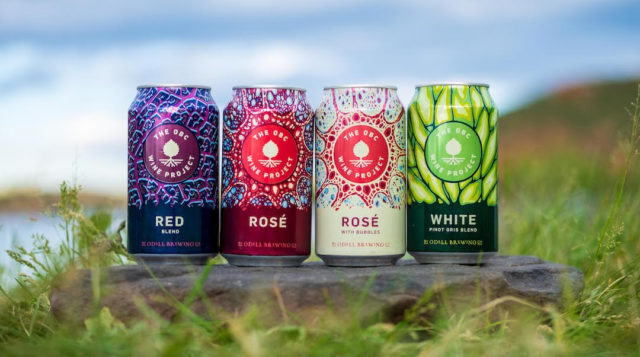
With the releases of Red, Rosé, Rosé with Bubbles and White on June 10, Odell Brewing Co.’s latest venture, The OBC Wine Project, is ready for its close-up. After 30 years in the brewing world, Odell is getting into the wine game.
Not that Odell is closing up shop and taking its iconic 90 Shilling and IPA with it — there will be plenty of malt, hops and yeast coming out of its Fort Collins brewery — but when the brewery announced in August 2019 it would start packaging a line of wine, the signal was clear: To stay afloat in the brewing world, you had to diversify.
Packaged in 12-ounce cans, The OBC Wine Project retails for about $8 a can, which is a pretty good deal for two glasses of quality wine. Red is fruit-forward and jammy, White is citrusy with refreshing minerality, and Rosé plays it subtle with nuances of strawberry and rhubarb. They pair nicely with dinner at home, but better with a picnic.
Four years ago, a brewery making wine was preposterous. Hazy IPAs were marching toward ubiquity, pastry stouts were catching fire, and sours were converting wine drinkers into beer drinkers. Many figured the future of beer lay in wild flavors, ancient and undiscovered styles and IPA by the barrel. But 2016 was also the year Mark Anthony Brands unleashed White Claw Hard Seltzer on an unsuspecting market. Its previous venture in the flavored-malt beverage (FMBs) sector, Mike’s Hard Lemonade, did well, but nothing like White Claw. Popularity grew slowly, and then quickly, even out-pacing Budweiser sales in July 2019.
Budweiser punched back earlier this year, releasing Bud Light Seltzer. They are not alone; five Boulder County breweries package a line of hard seltzer with a sixth, Left Hand Brewing, packaging a non-alcoholic line of seltzer water infused with CBD.
And that’s just the beginning. Ska Brewing’s Ska Street outpost on Arapahoe Avenue also incorporates a distillery, Peach Street Distillers, co-owned by Bill Graham and Dave Thibodeau of Ska, and Rory Donovan.
Hailing from Palisade, Peach Street has never shared a facility with Ska (headquartered in Durango), but when the former FATE Brewing Company facility came available, Boulder proved to be ideal for a joint location. FATE had planned to expand the brewery and incorporate distilling when the company went belly up in 2019.
The jump from brewing to distilling isn’t unprecedented. Spirit Hound Distilleries’ co-founder and head distiller Craig Englehorn used to brew, too — he helped design the original Dale Pale’s Ale for Oskar Blues Brewery back in the late-’90s. Now Oskar Blues has a line of seltzer (find them here), and Englehorn has a line of spirits.
Regardless, there are still more than 50 breweries in the county that have neither. And, as long as you’re small, another beer on the menu is diversification enough. But in a world where the bigger breweries are fighting for shelf space in the absence of tap handles and packed tasting rooms, breweries exploring non-beer products appear to be the next frontier.
The curious case of seltzer
Though they aren’t all made the same way, they all aim for similar results: 100-ish calories, one-ish grams of carbs, one-ish grams of sugar, 5% ABV and gluten-free. How they get there is their own business, but usually follows this trajectory: Sugar (cane) water is fermented with yeast and then dosed with water-soluble flavors: Yumberry, juniper and lime, grapefruit, etc.
That’s where the story ends. When we talk about beer, we talk about what’s in the glass: The ingredients used and where they may or may not come from. The style of beer and what it may or may not say about the origins of the beverage. The brewer and what they may or may not have wanted to bring to the beer. Techniques involved, food pairings and so on. Seltzer is the exact opposite.
Seltzer is about what’s not in the glass: Calories and carbs, gluten and aggressive flavors. Whereas hop-saturated IPAs and heavily roasted stouts smack you in the mouth with flavor, seltzers are specifically designed not to. They’re meant to taste crisp when it’s hot outside, refreshing in the club and light enough not to blow out your palate with bitter, sweet or sour. For some, they’re a pre-charged mixer, for others, Le Croix with an edge. And any way you slice it, they’re the key component to growth in the beer market these days.














